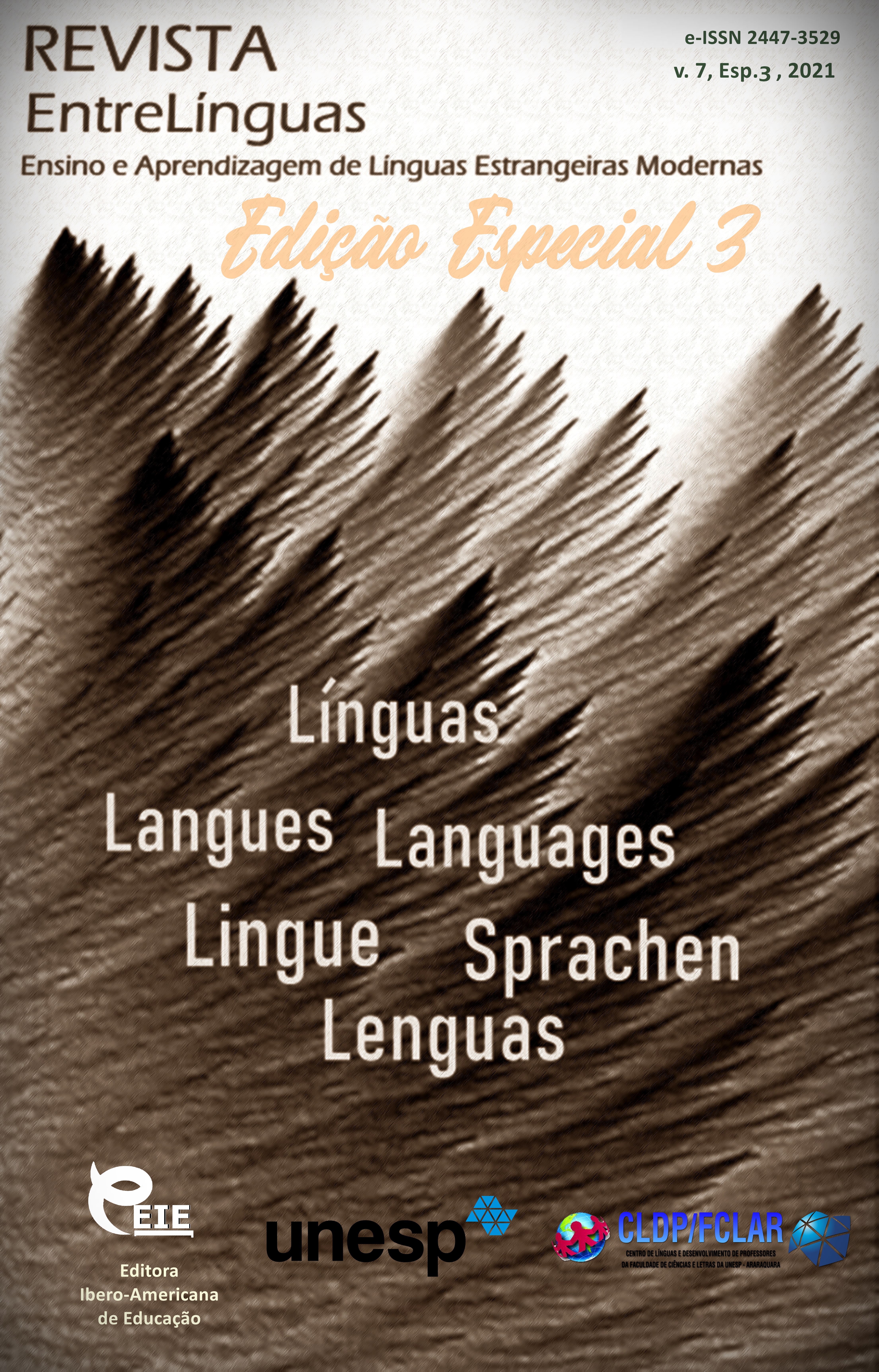Características fonoestilísticas da pequena prosa de E. Canetti
DOI:
https://doi.org/10.29051/el.v7iesp.3.15714Palavras-chave:
Material de curso on-line, Alunos do EFL, Capacidade de escritaResumo
A linguística como ciência da linguagem, sua natureza e funções sociais, as leis de seu funcionamento, o desenvolvimento histórico inclui muitas seções que consideram vários aspectos da linguagem - em primeiro lugar, sons (fonética, fonologia), palavras (morfologia), frases (sintaxe) e valores (semântica). Uma dessas seções é a fonoestilística, cuja tarefa é estudar os aspectos sonoros da fala, a organização sonora do texto e os efeitos sonoros em uma obra de arte. Os meios fonéticos da estilística são a frequência dos fonemas, as repetições do som, a reprodução do som e o uso de rimas. O estudo de uma obra de arte do ponto de vista da fonética desempenha um papel especial na medida em que a análise do uso de meios fonéticos (melodia, ritmo, andamento, tom, sotaque, velocidade de fala, uso de certos sons) em um texto, suporte sonoro, significado estilístico do subtexto ajuda a revelar a intenção ideológica do autor e a compreender a profundidade estética e emocional de uma obra. O objetivo deste artigo é considerar os traços fonoestilísticos, ou melhor, rítmico-entonacionais da prosa curta de Elias Canetti; por conveniência, usaremos o termo “miniatura”, “história” neste artigo, reconhecendo certas convenções dentro dessa modificação de gênero.
Downloads
Referências
ALLEMANN, B. Elias Canetti: ein ohrenzeuge. In: Hüter der verwandlung. Beiträge zum Werk von Elias Canetti. München: Hanser, 1985. p. 237-245.
CANETTI, E. Der ohrenzeuge. Fünfzig charaktere. Moscow: Fischer Taschenbuch Verlag, 1995. 96 p.
CANETTI, E. The man of our century. Translation by N.S. Pavlova. Moscow: Progress, 1990. 474 p.
HANSEL, M. Elias Canetti: das hörwerk 1953–1991. Prosa, dramen, essays, vorträge, reden, gespräche. Hg. von Robert Galitz, Kurt Kreiler und Katharina Theml. Moscow, 2005.
HARTUNG, R. Der ohrenzeuge und andere charaktere. Canetti lesen. Erfahrungen mit seinen Büchern. Hanser , 1975. p. 86-90.
LAEMMLE, P. Macht und ohnmacht des ohrenzeugen. Canetti lesen. Erfahrungen mit seinen Büchern. München; Wien: Carl Hanser Verlag, 1975. p. 47-61.
REINISCH, L. Elias Canetti und seine kritiker. In: Merkur. 1975. p. 884-887.
SHASTINA, E. M. The creativity by Elias Canetti: problems of poetics. Kazan: Publishing House "FAN", 2004. 288 p.
SHASTINA, E. M. Typification of the era in "50 characters" by Elias Canetti: on the problem of genre. Scientific Dialogue, v. 8, n. 56, p. 84-96, 2016.
Downloads
Publicado
Como Citar
Edição
Seção
Licença

Este trabalho está licenciado sob uma licença Creative Commons Attribution-NonCommercial-ShareAlike 4.0 International License.
Os manuscritos aceitos e publicados são de propriedade da Revista EntreLínguas. Os artigos publicados e as referências citadas na Revista EntreLínguas são de inteira responsabilidade de seus autores.
Transferência de direitos autorais – autorização para publicação
Caso o artigo submetido seja aprovado para publicação, já fica acordado que o(s) autor(es) autoriza(m) a UNESP a reproduzi-lo e publicá-lo na EntreLínguas, entendendo-se os termos “reprodução” e “publicação” conforme definição respectivamente dos incisos VI e I do artigo 5° da Lei 9610/98. O artigo poderá ser acessado pela rede mundial de computadores (Internet), sendo permitidas, a título gratuito, a consulta e a reprodução de exemplar do artigo para uso próprio de quem a consulta, desde que haja a citação ao texto consultado. Essa autorização de publicação 328 EntreLínguas, Araraquara, v. 1, n .2, p. 323-328, jul./dez. 2015 não tem limitação de tempo, ficando a UNESP responsável pela manutenção da identificação do(s) autor(es) do artigo. Os artigos publicados e as referências citadas na Revista EntreLínguas são de inteira responsabilidade de seus autores.











